Broa, Northern Portugal

This broa I made yesterday looks just like my late Gran use to make. I was really pleased with the look of it. I have my kind cousin in Lisbon to thank for it because she managed to organise the out of print copy of the Portuguese bread book, O Paõ Em Portugal from the publishers and couriered over to me. The net is full of broa recipes but I found none that look like this. These are very traditional Northern Portuguese loaves made from mainly corn and some rye and use to be baked in every household in wood fired ovens. My gran was a farmer and grew the corn, rye and some wheat, she would make it in batches to last the week, some would make enough for a fortnight.
It’s made from a high proportion of maize flour with some rye and in some recipes like this one it has a small amount of wheat. It’s a dense moist bread, I would describe the texture similar to rye breads. From left-over broa you make the well known migas, a dish of the crumbled bread fried in fat and used to accompany dishes.

As soon as I received the book the two Northern breads I wanted to try was the local named rosca otherwise known as regueifas, a traditional soft wheat bread shaped in a wreath, a speciality at Easter and this broa. My intent was to try the rosca first but when I twitted about it I had the bread obsessed Jeremy from Stir the Pots egging me on to make the broa and Joanna Zeb Bakes joined in. I gave some poor excuse I couldn’t because it was going to take some time to translate, the notes didn’t seem to match the recipe…I had to figure what to do to replace the “old dough” the recipe required…never scalded flour…oh there was a whole list of reasons I was telling myself I couldn’t do it just yet.
Yes…basically I was stalling and Jeremy challenged me on it…he said, “Give over!” and worse still he was asking for the recipe to make it himself. Hate it when people challenge me on something I can most likely do because it means I’ll take it on. Very glad he did and also extremely grateful he sent me a video he found of an old lady baking her broas in a wood fired oven in Northern Portugal, here. The old lady put the loaves in her stone made oven and closed it with the iron door and then sealed around the edges with cow dung just like my Gran use to.
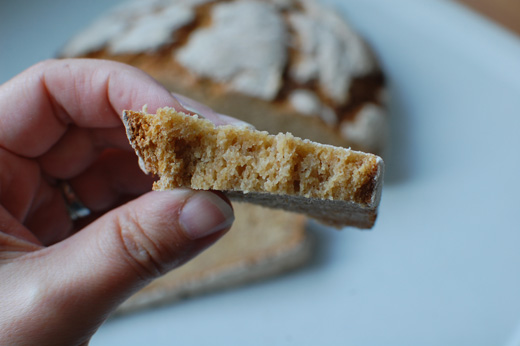
Does It Taste Like My Gran’s Broa?
I tasted the broa yesterday and today and as I suspected it taste better the day after baking. Given that I was not expecting this loaf to rise let alone look like anything edible I was really pleased with the taste of it.
The big question is whether it tastes like I remember my Gran’s broa…well I don’t remember how my Gran’s use to taste because I was very young. I just remember my Grandad from my mother’s side taking me over to see her on his motorbike, when I was very young he use to put me between him and the petrol tank of the bike because I was too small to hold on at the back. I remember my Gran having these loaves on the table along with wine she made and food but have no recollection of the taste, it wasn’t something I tasted everyday.
Watching the video Jeremy sent gave me a flashback to my Gran’s farm because the table the old lady used to mix, knead and prove was the exact same table my Gran had in her kitchen. The old lady in the video can’t knead bread anymore so her daughter does the kneading and she does the rest. The daughter explains in the video how her mother is convince the broas don’t taste the same as the ones she use to knead herself. This is what happens. In my family there will be endless conversations about how one dish using the same ingredients will taste different made by the different members.
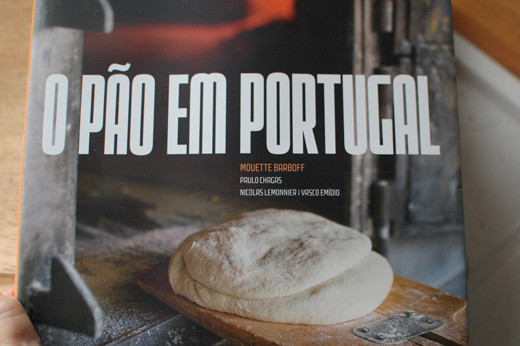
What My Dad Said About the Broa
My dad is here at the moment so it was the perfect opportunity to ask him what he thought of the broa and how close it tasted to his mother? He said it didn’t taste like hers. His mother’s broa was sweeter and the texture was coarser.
After a long discussion about the video I showed him and about his memories of taking his mother’s corn and rye to the mill to grind down, he says the maize flour was white not yellow. His mother use to grow white for bread because it was sweeter and yellow for chicken feed.
The other interesting fact he remembers about taking the cereal to the mill was his mother’s insistence that the miller was to grind her corn only after he had freshly re-surface the stone. I don’t know how to explain this in English but the word in Portuguese my Gran used for this was Picadura, which meant the following; after some grinding the mill’s stone would go smooth and he would re-surface it by using a pick and making little tiny holes in the stone, giving the flour a coarser texture. My Gran would use the word Safadura to mean the flour being grind by the stone when it went smooth again, which is something she didn’t want, she wanted her flour to be ground to a coarser texture from the Picadura.
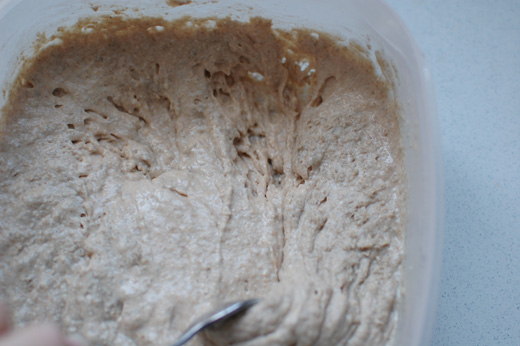
The recipe require to use some old dough and feed it as it’s starter. I decided to feed my white wheat levain with some rye flour.
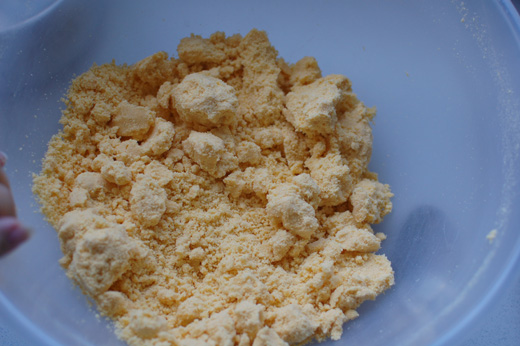
It said to scald the maize flour which I’ve never done before, I was suppose to make it moist but not too wet.
What looks like dry crumbly maize flour is not.
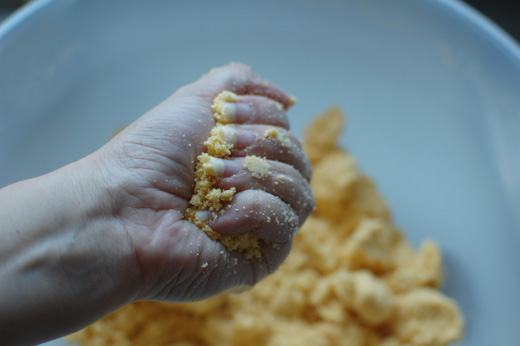
As soon as you clump it together in your hand.
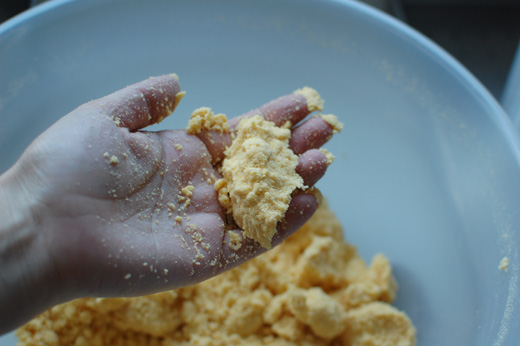
It comes together into a lump showing the flour is moist.
After the scalding of the maize flour and leaving it to rest for 30mins you mix it with the starter, rye flour, wheat flour, baker’s yeast, salt.
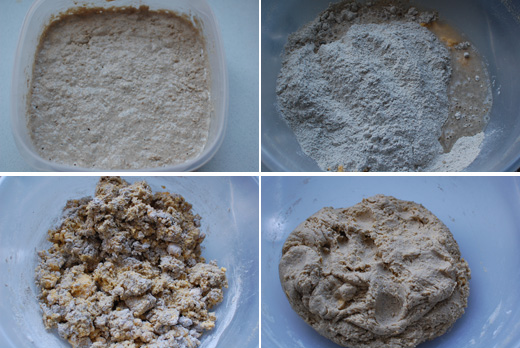
This book is for small bakeries and the recipes are in large quantities and the kneading done by mixers. I had to knead it by hand since don’t even possess a domestic mixer.

Required a decent amount of kneading to make certain all the maize lumps were amalgamated properly.
I found it easier to knead it in my very large bowl than on the board.

Kneaded it for about 15mins…which makes this a labour of love since I hate kneading.
It was the strangest dough I’ve made or felt, no elasticity from the lack of gluten, perfect for playdough.
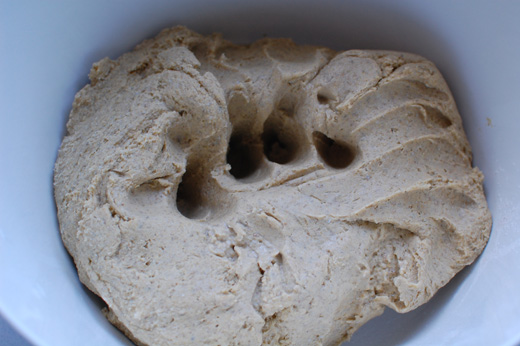
I seriously looked at this dough and thought ‘There’s no way this cement looking lump is going to rise’.

To my surprise it did.
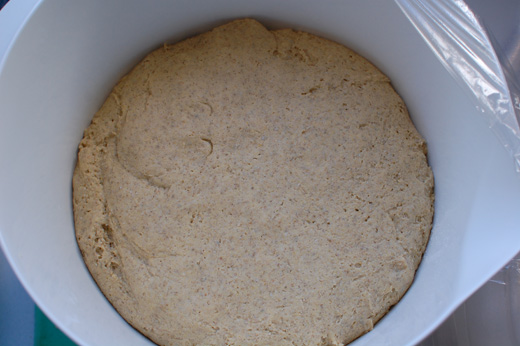
It was just as well I watched the video because without seeing the old lady shaping the loaves in a bowl by moving the bowl around and using the sides of it to form the shape I would have got myself into a bind when it came to shape my loaf.
When the dough rises it has this unusual texture but there’s no stringyness to it like the wheat doughs I’m use to so it breaks apart really easily, it’s impossible to handle for someone like me who’s not use to this.
I had also forgotten to let it prove it in a proving basket dusted with flour like the recipe suggests. As soon as I realised my mistake I followed the old lady in the video and put the dough into my largest bowl dusted with lots of flour moving it about making a huge floury mess but it worked, I had a shape. Baked for an hour.



Next time I want to use white maize flour, a whiter rye flour. I would like to also eventually change the proportions of the baker’s yeast by decreasing it in favour of a higher ratio of starter.
For now I was just proud of the fact it looked right.
